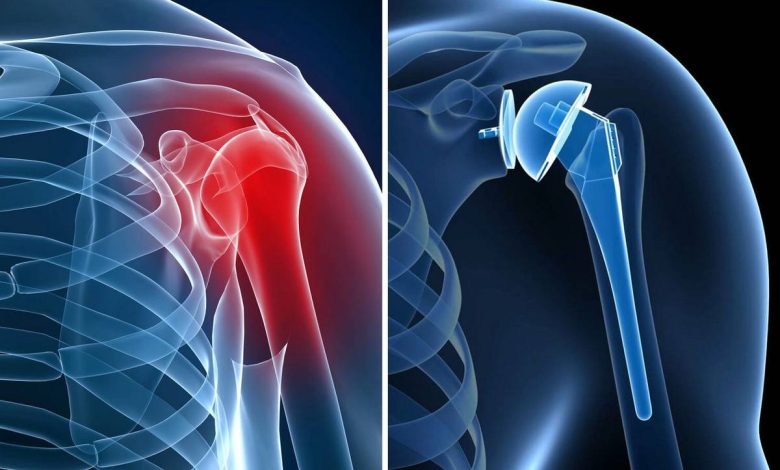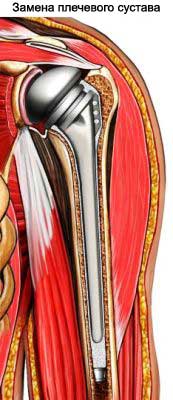Shoulder Joint Replacement, shoulder arthroplasty: what is this operation, causes, Contraindications, how they do it, what after

Description of the shoulder joint replacements
Shoulder Joint Replacement – operation, which is performed to treat a variety of diseases and shoulder injuries, such as:
- Severe shoulder fractures;
- Osteoarthritis;
- Rheumatoid arthritis;
- Rotator Cuff Injuries;
During the operation painful, Worn shoulder joint is replaced by a new, Made of metal and plastic.

The reasons for the replacement of the shoulder joint
The operation relieves pain of the shoulder joint, caused by disease or injury shoulder.
Possible complications of the shoulder joint replacements
Complications are rare, but the procedure does not guarantee the absence of risk. If you plan to shoulder arthroplasty, you need to know about possible complications, which may include:
- Rigidity (stiffness) Shoulder;
- Shoulder Instability;
- Infection;
- Nerve damage shoulder;
- The displacement of the shoulder joint.
How is the replacement of the shoulder joint?
Preparation for the procedure
Before the surgery, you need to meet with the doctor for medical examination, studying history and analyzes. Your doctor may order the following:
- Blood tests;
- Roentgen – test, which uses X-rays to take pictures of structures inside the body;
- CT scan – such as X-rays, which uses computer, to make pictures of structures in the shoulder;
- Magnetic resonance imaging – test, which uses magnetic waves, to make pictures of structures in the shoulder.
Tell your doctor about taking any medications. A week before surgery, perhaps, you need to stop taking certain drugs:
- Aspirin and other nonsteroidal anti-inflammatory drugs (eg, Ibuprofen, naproxen);
- Blood-thinning drugs, such as warfarin;
- Antiplatelet drugs, like clopidogrel;
- Medications for arthritis.
Anesthesia
The operation is performed under general or regional anesthesia.
General anesthesia blocks pain and the patient support in a sleep state during operation. Administered intravenously in the arm or hand.
Regional anesthesia blocks pain in a certain part of the body, in this case the upper body anaesthetized. During surgery, the patient is awake. It is injected into a vein in the arm or shoulder.
Description of the shoulder joint replacement procedures
The doctor makes an incision in the skin of the shoulder. Large shoulder muscles are moved apart in the parties, to gain access to the joint. Running incision in the rotator cuff. Rotator cuff consists of the tendons, that encloses and supports a shoulder joint. The incision allows the doctor to have a clear idea of the structure of the shoulder joint.
The doctor then removes the shoulder joint and replaces it with an implant, which looks very similar to a real.
After the implant doctor sews closes and the rotator cuff, muscles and skin. It can be installed drainage tube to remove fluid, that can accumulate in the shoulder after surgery.
Immediately after the replacement of the shoulder joint
You will be directed to the chamber to restore, which will be monitored vital parameters – blood pressure, pulse and breathing. They can be made X-rays of the shoulder.
How long will the replacement of the shoulder joint?
Several hours.
Shoulder Joint Replacement – Will it hurt?
Anesthesia prevents pain during surgery. Pain or soreness during recovery are removed with the help of painkillers.
The average time of stay in the hospital after the replacement of the shoulder joint
The operation is performed in the hospital. Usually the duration of stay of 2-3 day. Your doctor may prolong hospitalization, If there are complications.
Care after total shoulder joint
Care in a hospital
The very next day after the operation can be assigned to physical therapy. A physical therapist will help to restore range of motion and strength of the shoulder. Physical therapy to continue after hospital discharge.
Home Care
During the first few weeks after the operation will be supported by a special arm bandage, until the shoulder heals. You can perform simple tasks, such as eating and donning garments approximately two weeks after surgery. At the same time, family members or friends can help you in daily activities.
After returning home, follow these steps:, to ensure the normal recovery:
- Follow your doctor's instructions to support the incision area clean and use the sling;
- Ask the doctor, when it is safe to shower, bathe, or to expose the surgical site to water;
- Ask your doctor about, when it is safe to drive;
- Be sure to follow all instructions from your doctor.
Contact your doctor after shoulder joint replacement
After discharge from the hospital need to see a doctor, If the following symptoms:
- Stiffness, pain or instability in the shoulder;
- Problems in location incision (eg, bleeding, allocation);
- Signs of infection, such as fever or chills.
